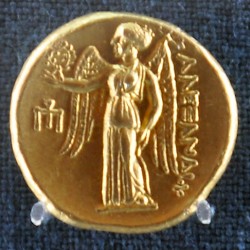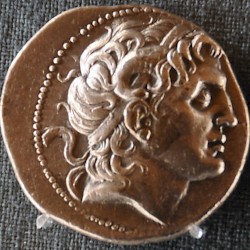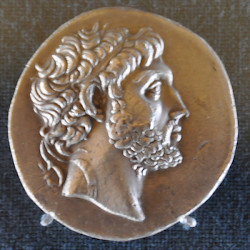Athens, Numismatic Museum
Q658339Dimitris Chatzis’ To diplo biblio (“the double book”) is one of my favorite novels, and because I recently met a German-born Greek who hadn’t heard of this story about Greeks in Greece and Germany, I decided to buy the modern classic. It turned out to be a fool’s errant. This afternoon, I visited seven bookshops where everyone agreed that it was one of the best Greek novels and everyone was surprised to find it out of print. If this wasn’t depressing enough, I was in one of the ugliest parts of Athens, Panepistemiou Street, disgraced by several neoclassicist university buildings that would have ruined my day even if I had been able to buy my book.
One of the less tasteless buildings is the former house of Heinrich Schliemann: designed by Ernst Ziller and called Iliou Melathron by its owner, it now hosts Athens’ Numismatic Museum. The great archaeologist may have wanted to build a “house of Troy”, but it looks more like a Palladio villa than a Neohellenistic building. The decoration is well-preserved and the paintings are not bad, for the nineteenth century. This alone would justify a visit.
The collection is splendid. You will see hundreds of Greek coins, most of them ancient, but on the second floor, there is an exceptionally fine collection of Byzantine coins, and there are more modern examples too. In the first room, you will find some information on the origin of the house, and in two double displays, you will see Schliemann’s own coins. It makes you realize what an advance numismatics have made in just a bit more than a century.
In the next rooms, you get information about the origin of coinage – I especially loved the six bronze spits (obols!) from the Heraion near Argos. The coins themselves are presented by category: flowers, animals, mythology, statues, buildings, and so on. You will also get information about the way coins were produced, about inflation, or about hoards (beautifully displayed). Of course there are also various displays that show the regional variation: coins from the Greek city states, from Asia Minor, from Magna Graecia.
As I said, the more recent coins are on the second floor. You will also find medals and seals. I was impressed by the seal of the Venetian doge Dandolo, the half-blind man who more or less singlehandedly put an end to the Byzantine Empire.
Photography is allowed, but I discovered that taking too many photos is frowned upon. The guards remained friendly, I hasten to add, but I must confess that I always find it a bit frustrating if photography is made difficult. Museums should allow and not obstruct study, which means that visitors must be able to see the objects again at home. Besides, the best PR a museum can have is visitors enthusiastically telling other people that a museum shows interesting objects and illustrating this with pictures. (In the Bode Museum and the British Museum, which have similar numismatic collections, photography is easier.)
This being said, I conclude that I found the museum very nice and recommend it. Unlike the crowded Agora Museum, which I had visited earlier today, it is perfectly quiet. Again, I am grateful to the Greek government, which spends lots of money to splendid museums. The catalog, Coins and Numismatics (1996) is beautiful and very reasonably priced (€36). All in all, Athens’ Numismatic Museum is certainly worth a visit.
This museum was visited in 2010.
3 pictures related to this museum
 Coin of Alexander, commemorating Nearchus' naval campaign |
 Alexander the Great, coin by Lysimachus |
 Philip V of Macedon, coin |